You’ve probably heard this line before:
“We stand out because of our amazing product.”
And sure, having a great product or service is important. But today, that alone isn’t enough to keep customers coming back.
What truly separates good companies from great ones is how they treat their customers.
A confusing website, an impersonal chatbot, or a frustrating customer service call is all it takes for a customer to walk away, sometimes permanently.
The truth is that most customers won’t give feedback before leaving. They won’t tell you they’re unhappy, they’ll just disappear.
So, what does the latest data reveal about customer expectations? Where are companies focusing their customer experience (CX) strategies? And what steps can you take to stay competitive?
Let’s explore the key trends, real-world statistics, and practical insights shaping the future of CX.
1.
CX is a key growth driver
Let’s start with the business case.
Customer experience isn’t just a “feel-good” concept. It has a real, measurable impact on revenue, profitability, and long-term growth.
Studies show that companies with strong CX programs grow 4 to 8% faster than their competitors. (Bain & Company)
Customer-centric brands also earn 60% higher profits than those that don’t prioritize experience. (Deloitte)
Even more revealing, a Forrester study found that 41% of CX-focused companies saw at least 10% revenue growth in their last fiscal year. Among less mature companies, only 10% achieved the same.
CX isn’t a cost center — it’s a growth strategy.
2.
Personalization and data are leading the way
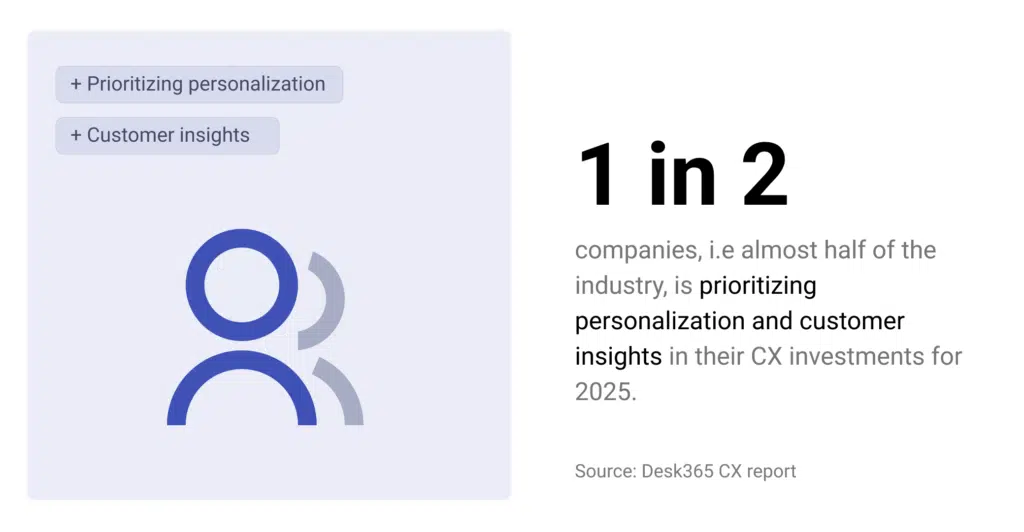
Today’s customers expect experiences that are not just good but tailored.
Generic content and one-size-fits-all messaging don’t work anymore.
According to Desk365:
- 1 in 2 companies, i.e, almost half of the industry, is prioritizing personalization and customer insights in their CX investments for 2025.
- 44% are investing in data integration and analytics to make that personalization possible.
With better data, companies can understand preferences, behaviors, and expectations — and use that insight to create smarter, more relevant experiences.
Personalization isn’t just about calling someone by name. It’s about making them feel seen and understood.
3.
Automation is reshaping support
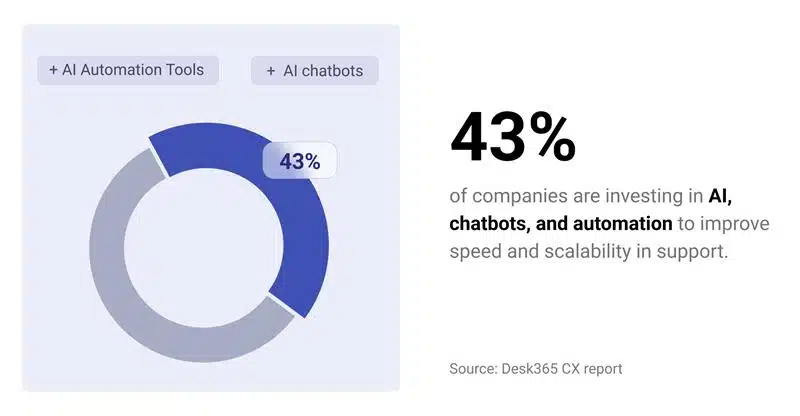
Customer service isn’t just reactive anymore. It’s fast, scalable, and increasingly automated.
Desk365 reports that:
- 43% of companies are investing in AI, chatbots, and automation to improve speed and scalability in support.
This shift isn’t about replacing humans — it’s about removing friction.
Automation handles repetitive tasks, improves response times, and frees up human agents to focus on complex, high-value issues.
And customers appreciate it. 67% say they prefer self-service over speaking to a representative. (Zendesk)
When done right, automation creates speed without sacrificing empathy.
4.
Feedback Is your most valuable insight
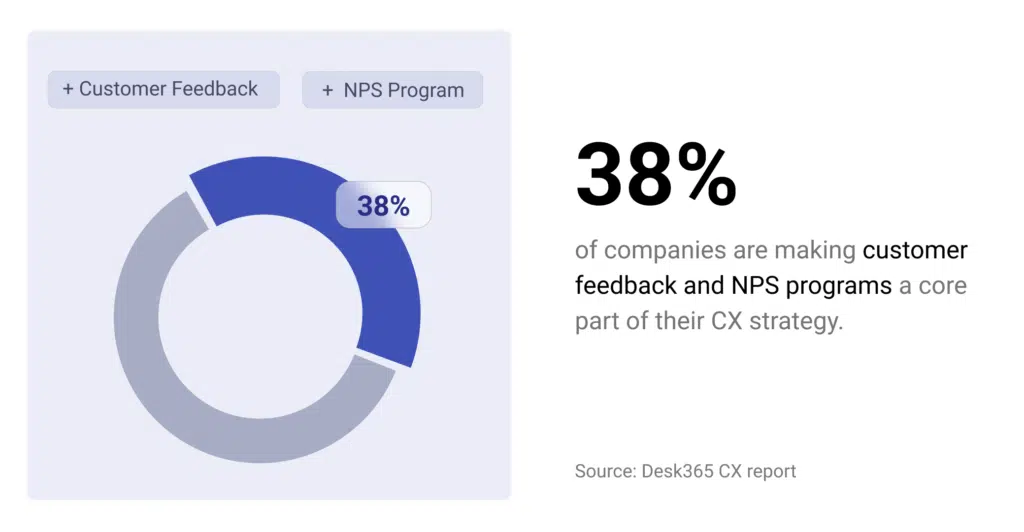
If you want to improve your CX, start by listening.
38% of companies are making customer feedback and NPS programs a core part of their CX strategy.
Gartner found that 63% of CX leaders say improving how they collect and act on feedback is a top priority.
And the results speak for themselves — companies that manage feedback effectively see a 10x boost in customer satisfaction. (Aberdeen Group)
Even better, those who link CX metrics to business outcomes are 29% more likely to succeed. (Qualtrics)
Feedback isn’t just a data point. It’s your most direct line to what matters to your customers.
5.
Omnichannel is the new standard
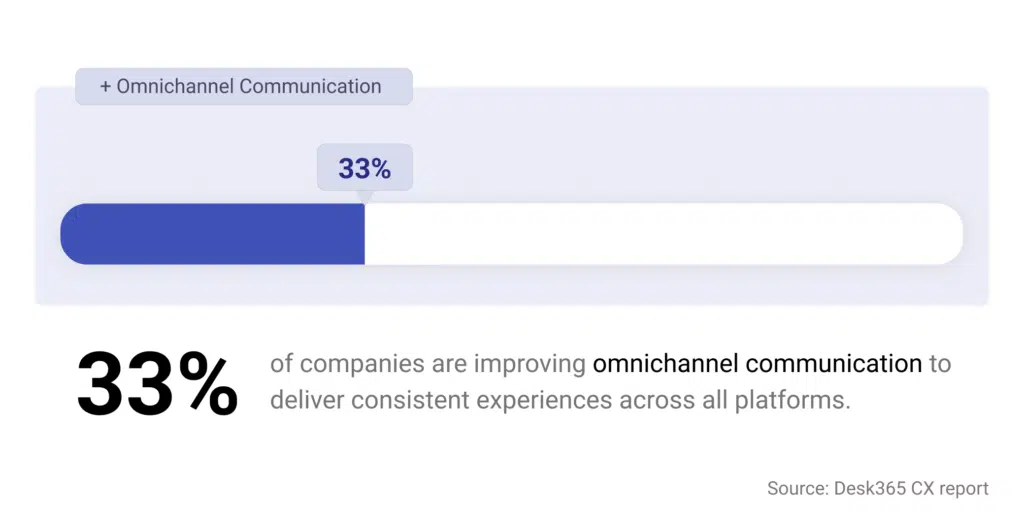
Customers don’t just stick to one channel anymore.
They bounce between websites, apps, email, social media, and chat — and they expect the experience to stay consistent throughout.
That’s why 33% of companies are improving omnichannel communication to deliver consistent experiences across all platforms. (Desk365 CX report)
Companies with strong omnichannel strategies see major benefits:
- 10% annual growth
- 10% higher average order values
- 25% increase in conversion rates (PwC and Adobe)
Great brands, like IKEA, have nailed this by delivering a smooth, unified experience online, in-store, and through mobile.
6.
Mobile CX still has room to grow
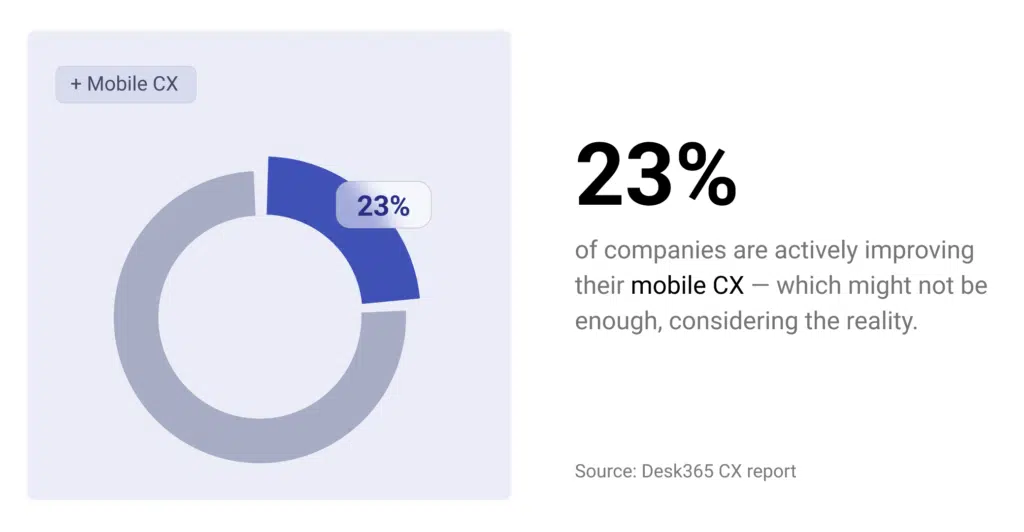
Mobile isn’t just another channel. For many customers, it’s the primary one.
Desk365 reports that 23% of companies are actively improving their mobile CX — which might not be enough, considering the reality.
- 57% of users won’t recommend a business with a poor mobile site
- 50% will stop visiting a site altogether if it’s not mobile-friendly
- 90% report frustration when using support tools on mobile devices (Google Think Insights)
A slow, clunky mobile experience can quickly damage your brand — even if everything else is great.
7.
The full journey matters

It’s not just about individual touchpoints. The entire customer journey must be considered.
According to Desk365, 24% of companies are focusing on customer journey mapping to identify friction points and improve flow.
Companies that map and optimize customer journeys see 54% better ROI from their marketing investments. (Aberdeen Group)
This big-picture view helps teams align sales, marketing, and support around the same goal — a smooth, seamless experience.
8.
Support still counts (But it's changing)

Human support is still essential — especially when things go wrong.
Desk365 notes that only 19% of businesses are currently improving traditional support tools, like live chat or help desks.
A third of the companies interviewed are expanding self-service options like help centers and FAQ.
That’s a missed opportunity, because:
- 82% of customers say getting a fast response from a real person is critical to a good experience (Salesforce)
- Live chat delivers the highest satisfaction ratings among all channels (Zendesk)
Automation may handle routine issues, but great support teams build real relationships.
9.
Great CX builds real loyalty
A positive customer experience doesn’t just drive satisfaction. It builds emotional loyalty.
It turns one-time buyers into repeat customers and transforms satisfied customers into brand advocates.
According to Forbes, 73% of customers say experience is what drives their loyalty and 77% are more likely to recommend a brand after just one good interaction.
Even more striking, 86% of buyers are willing to pay more for a better experience.
In today’s competitive market, experience can outweigh price, speed, or even product features.
10.
Poor CX costs you customers
While great CX builds loyalty, a single bad experience can do the exact opposite.
One in three customers will leave a brand they love after just one poor experience. (PwC)
That’s right — just one.
And most of the time, you won’t even know it happened. According to customer experience expert Esteban Kolsky, only 1 in 26 unhappy customers actually complain. The rest simply leave — often without saying a word.
PwC reports that 32% of customers stop doing business with a company after one bad interaction, even if they were loyal before.
So don’t assume silence means satisfaction. Often, it means lost opportunity.
11.
Companies are investing more in CX
Businesses are catching on.
Customer experience is no longer considered a “nice-to-have” — it’s a competitive necessity.
A whopping 90% of companies say CX is now their top priority. (CX Index)
And they’re putting their money where their mouth is.
The Zendesk CX Trends Report reveals that 80% of business leaders plan to increase their customer service budgets in the next year.
This shift aligns with a major trend:
89% of companies now compete primarily on customer experience, compared to just 36% in 2010. (Gartner)
Those who adapt fast will lead. Those who lag risk becoming irrelevant.
Final thoughts: CX is everyone’s job
Creating great customer experiences isn’t just the job of your support team. It touches every department, from marketing and product to sales and customer service.
Here’s the good news: you don’t have to fix everything overnight. Start small. Prioritize the most impactful areas. And listen, really listen, to your customers.
Because at the end of the day, customer experience is what keeps people coming back.
In a world full of choices, that might be the most important investment you make.




